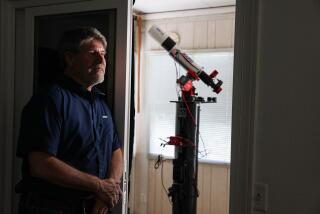Sky’s the Limit for Amateur Stargazers
- Share via
Stargazer Dave Holland can be pretty hard-core about his hobby. He thinks it’s no big deal to lug 300 pounds of telescopes and equipment to chilly mountaintops to determine which of Jupiter’s shifting moons might be rounding the giant planet on any given night.
His personal library contains about four dozen books about astronomy, and he subscribes to two monthly astronomy magazines.
The 40-year-old once spent two weeks on a 2,000-mile, round-trip pilgrimage to the tip of Baja California to watch a total solar eclipse that lasted about 61/2 minutes.
Such fervor is common among members of the Ventura County Astronomical Society, which is marking its 45th anniversary this year. From a handful of hobbyists in 1957, the group has grown to 150 and it sponsors educational programs for local students in addition to lobbying developers to reduce so-called light pollution.
In August, the society lobbied the developer of a 20,000-home project near Mt. Pinos to use more efficient outdoor lights that don’t obscure the night sky. The developer agreed in principle.
“This is the first real big design win,” said society President Mike Chibnik of Simi Valley, adding that it didn’t hurt that the appeal for light conservation came in the middle of a statewide energy crisis. “Electricity is something that you don’t want to throw away.”
Holland, a stock clerk for an electronics firm, volunteers as a teacher’s aide for Moorpark College astronomy classes. He said he has seen most everything an amateur can see in the night sky--from planets and moons to nebulae and comets. But he continues to search the heavens.
“Even now, I always find something new,” he said.
Holland joined the astronomical society after his parents gave him a telescope for his 15th birthday. When he peered into the night and saw the rings of Saturn, he was hooked. “That was so cool to see that for the first time,” he said.
Holland dived into his new hobby. “I learned the sky by physically reading the books, physically memorizing the star charts,” he said. “I like hunting for the object as much as actually finding it.”
Holland, who edits the society’s newsletter, now owns five telescopes and has had dozens of his celestial photographs published.
He and other society members regularly take their equipment to local schools to give kids--and sometimes adults--their first close-up look at the planets.
“For me, that’s a thrill,” he said. “I’ve been doing it for so long that sometimes I take it for granted that everyone’s looked through a telescope.”
The astronomical society meets a few times a month to learn about stars, photograph distant objects or view star clusters during a new moon, when visibility is better. The society, which also has a youth division, typically meets the third Friday of the month with a presentation at Moorpark College.
A guest lecturer covers topics such as solar eclipses, comets or the International Space Station, and visitors hear about upcoming celestial events of interest, such as the reappearance later this month of Venus and Mars after sunset.
Other club events include sky-watching parties at Mt. Pinos in Los Padres National Forest.
Interest in astronomy seems to wax and wane, depending on NASA’s success with its orbiting telescopes and planetary probes, Holland said.
Simi Valley resident Mike Lanska joined the society three years ago after his wife bought him his first telescope. The general contractor was so enraptured with what he saw through the 4-inch-diameter lens that just a month later he donated the $200 telescope to a local school and invested in a more powerful $3,000, 8-inch-diameter, computer-controlled model with which he can take snapshots of distant stars.
Equipped with a global-positioning device, Lanska’s latest telescope finds objects with the press of a few buttons, and even follows them through the night sky as the Earth rotates.
FYI
For more information about stargazing and the Ventura County Astronomical Society, log on to www.vcas.org.
More to Read
Sign up for Essential California
The most important California stories and recommendations in your inbox every morning.
You may occasionally receive promotional content from the Los Angeles Times.










